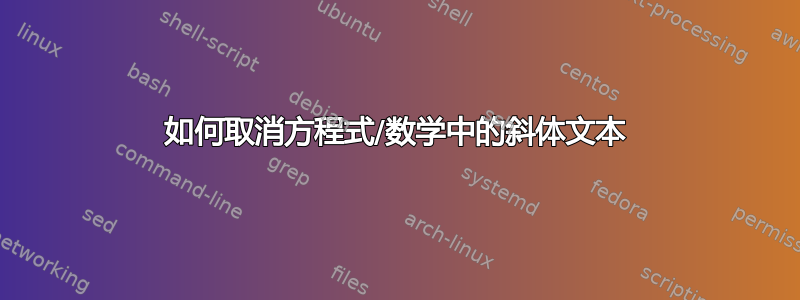
我对对齐方程内的文本有疑问。我对方程的对齐方式很满意,我想让部分文本不斜体。在代码中,我想让“where”不斜体。另外,我想让第二个等号彼此对齐,但我稍后会解决这个问题。
(MWE 提供塞巴斯蒂亚诺)
\documentclass[a4paper]{article}
\usepackage{mathtools}
\begin{document}
Aligning equal signs. Example.
\begin{equation}
\begin{split}
y_{destr} & = nL\lambda/2d, \text{where}\,\, n= \pm 1, \pm 3, \pm 5, \ldots \\
y_{constr} & = nL\lambda/d, \text{where}\,\, n = 0, \pm1, \pm2, \pm3, \ldots\\
\end{split}
\end{equation}
\end{document}
答案1
如上所述,\text宏是实现该目的的工具。我认为您还希望使用\mathrm(或\text) 作为 s 的下标y。并使用\dots而不是...。
对于对齐,alignat环境可以帮助您在两个等号处对齐。
此外,(1)和是方程编号吗?如果是,请不要手动将它们写出来,只需使用末尾(2)不带 a 的数学环境,它们会自动编号。*
最后,不要用 结束最后一行align(或类似的)\\,这会在数学显示后给您带来不必要的垂直空间(以及编号方程式的额外数字)。
\documentclass{article}
\usepackage{amsmath}
\begin{document}
\begin{alignat}{2}
y_{\mathrm{destr}} &= nL\lambda/2d, \text{ where } & n &= \pm 1, \pm 3, \pm 5, \dots \\
y_{\mathrm{constr}} &= nL\lambda/d, \text{ where} & n &= 0, \pm1, \pm2, \pm3, \dots
\end{alignat}
\end{document}
正如 Sam Carter 所建议的,最好在 处对齐,where而不是在第二个 处对齐=。或者,如果第二个n比第一个 更宽的符号/更长的表达式n,那么您可以在 和 处对齐where。=不过在这种情况下不会有什么不同。
\documentclass{article}
\usepackage{amsmath}
\begin{document}
Align at where:
\begin{alignat}{2}
y_{\mathrm{destr}} &= nL\lambda/2d, &&\text{ where } n = \pm 1, \pm 3, \pm 5, \dots \\
y_{\mathrm{constr}} &= nL\lambda/d, &&\text{ where } n = 0, \pm1, \pm2, \pm3, \dots
\end{alignat}
Align at where and =:
\begin{alignat}{3}
y_{\mathrm{destr}} &= nL\lambda/2d, &&\text{ where } & n &= \pm 1, \pm 3, \pm 5, \dots \\
y_{\mathrm{constr}} &= nL\lambda/d, &&\text{ where } & n &= 0, \pm1, \pm2, \pm3, \dots
\end{alignat}
\end{document}





